Cycloadditions of 1-iminylphosphirane complexes with allenes
2021-04-02JuanLiMingyueCuiRongqiangTianZhengDuanFranoisMathey
Juan Li,Mingyue Cui,Rongqiang Tian*,Zheng Duan*,Fran çois Mathey
College of Chemistry, Green Catalysis Center, International Phosphorus Laboratory, International Joint Research Laboratory for Functional Organophosphorus Materials of Henan Province, Zhengzhou University, Zhengzhou 450001, China
ABSTRACT A cascade carbonylative ring expansion and[2+2]/[4+2]cycloaddition of strained 1-iminylphosphirane complexes with aryl allenes were reported.The carbonylative ring expansion of 1-iminylphosphirane complexes provides an azaphosphacyclohexone complex intermediate with a C=P double bond.The following[2+2]or dearomatic[4+2]cycloaddition of this intermediate with allenes is modulated by the aryl substituents on the imino carbon.The regioselective[2+2] cycloaddition with 1,1-diarylallene provides an entry to bicyclo[4.2.0]octan-4-one skeletons featuring a four-membered phosphacyclobutane moiety.While dearomatic[4+2]cycloaddition was preferred with less aromatic naphthalene and yielded octahydrochrysene skeleton containing heteroatoms.
Keywords:Phosphirane Allene Ring expansion Cycloaddition Carbonylative Heterocycle
Strained three-membered rings such as cyclopropanes,oxiranes and aziridines have been widely used as key building blocks for the synthesis of various high-value medium-sized rings or peri-fused ring systems [1].However, the development of a similar chemistry with phosphiranes was somewhat hampered until now [2].Based on our continuous interest on the phosphorus heterocycle chemistry [3], we demonstrated that 1-acylphosphirane tungsten complexes rearrange into 1,3-oxaphospholene complexes with a highly reactive P=C double bond,which is a phosphorus analogue of the Cloke-Wilson rearrangement(Scheme 1a)[4].Recently,replacing the acyl group with an imino group led us to disclose a novel rearrangement of 1-iminylphosphirane complexes under a CO atmosphere.The successive cycloaddition with olefins yielded 7-aza-1-phosphanorbornane complexes(Scheme 1b)[5].More interestingly,in the presence of M(CO)6(M=W, Mo), the reactions of 1-iminylphosphirane complexes and alkenes provide annulated heterodecalins with high molecular complexity and skeletal diversity(Scheme 1c).The proposed mechanism includes the carbonylative ring expansion and dearomatic Diels-Alder reaction [6].
The carbonylative ring expansion of strained 1-iminylphosphirane complexes provides an azaphosphacyclohexone complex intermediate with a relatively stable C=P double bond.It is known that the highly reactive phosphaalkenes can give head-to-head[2+2] dimmers [7].On the other hand, cumulated double bonds impart an extra reactivity to allene,making it a remarkably active component participating in a variety of cycloaddition reactions[8].For example, the [2+2] cycloaddition reactions of allenes with imines afford azetidines, via a stepwise diradical mechanism rather than a concerted one-step mechanism[9].This prompted us to investigate the reaction behavior of azaphosphacyclohexone complex with allenes.
We initiated our studies by investigating the reaction of 1-iminylphosphirane 1a with 1,1-diphenylallene 2a in the presence of Mo(CO)6.As shown in Scheme 2, three kinds of products were isolated.The structure of 3aa was unambiguously established by the X-ray crystallographic analysis (Fig.1).The phosphorus atom attached to the central carbon atom of the allene.The strain within the 4-membered ring is obvious when looking at the long P1-C9 bond at 1.91 Å.The structure of 4aa was established by comparing the NMR data of similar structure depicted in Scheme 1c,and was identified by a characteristic =CH2resonance in the135dept NMR spectrum at δ=+131.7(JCP=21.2 Hz).Comparison of the NMR spectra of 4aa and 5aa, the disappearance of characteristic =CH2resonance and appearance of a new sp3CH2resonance at high-field indicated the formation of 5aa.Similarly,replacing the thienyl group in imino moiety (1a) by 2-naphthyl(1b) provided corresponding product 3ba along with 6ba.
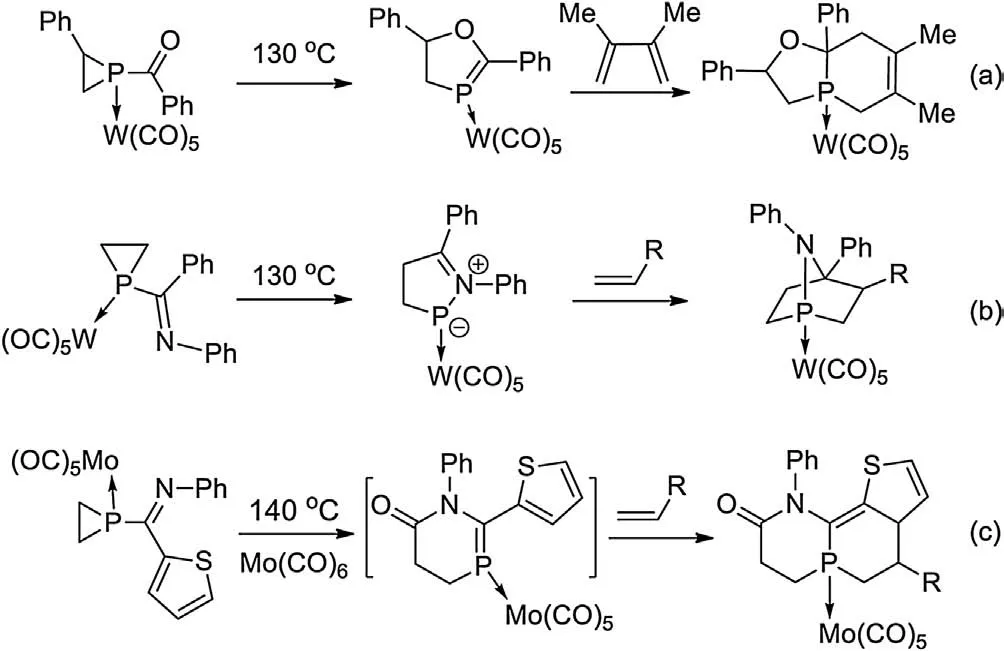
Scheme 1.Important ring expansions of phosphirane complexes.
To understand the reaction mechanism, the reaction was performed without 1,1-diphenylallene 2a.The31P NMR of crude reaction solution shows a new peak at +132 ppm which indicate the formation of intermediate 7 reference to the literature report[6].Subsequent reaction of 7 with 2a led to the formation of the expected 3ba and 6ba.Thus,a cascade mechanism for this reaction was proposed (Scheme 3).The carbonylative ring expansion of 1-iminylphosphirane complexes results in the formation of a reactive azaphosphacyclohexone derivative 7.When 7 undergoes[2+2] cycloaddition with the terminal double bond of allene 2a,the phosphacyclobutane fused 3ba is produced.The good regioselectivity of[2+2]cycloaddition to form 3ba probably due to the steric hindrance of two phenyl groups inhibited the reactivity of the internal double bond of allene.While, the interesting dearomatic[4+2]cycloaddition[10]of 7 with 2a gives peri-fused heterocycles 6ba.
Replacing thiophene and naphthalene substituents with benzenoid resulted in the selective formation of the [2+2]cycloadducts 3 (Table 1).These results indicated that the selectivity between [2+2] and dearomatic [4+2] cycloaddition reactions might be tuned by the aryl substituent on imino carbon.The reaction with 1c gave 3ca as a sole product in moderate yield(Table 1, entry 1).The efficiency was found to be related to the electron richness of the aryl group on imino carbon,a general trend followed the order electron rich (1d, entry 2, 55%) >neutral(1c, entry 1, 48%) >electron deficient (1e, entry 3, 35%).Electron donating group increases the electron density of C=P double bond in the intermediates which promote the activities of the C=P double bond towards to allenes.Both electron-rich(Table 1,entry 4)and electron-deficient(Table 1,entry 5)aryl substituted allenes worked smoothly with 1c and afford the corresponding [2+2]cycloadducts 3cb and 3cc.These [2+2] cycloadditions with 1,1-diarylallenes proceeded exclusively at the less substituted double bond.When a less steric hindered 1-phenylallene 2d was employed, both double bonds in allenes could participate in the[2+2] cycloaddition and yielded a pair of regio-isomers (Table 1,entries 6 and 7).All the new P--C bonds were selectively formed with the central carbon of allenes.Unfortunately,this reaction did not proceed with electron-poor allenoate(Table 1,entry 8).
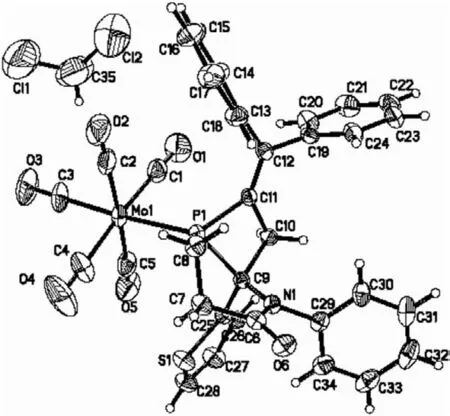
Fig.1.Molecular structure of diphosphane 3aa.Selected distances [Å] and angles[°]: P1-C8 1.833(4), P1-C9 1.909(3), P1-C11 1.822(2), C9-C10 1.564(4), C10-C11 1.511(5), C11-C12 1.330(5), P1-Mo1 2.4930(9).C8-P1-C9 103.55(16), C8-P1-C11 111.04(18), C9-P1-C11 76.51(15).
The result with 1-phenylallene 2d promoted us to revisit the reaction behaviors of thienyl and naphthyl substituted 1a and 1b with the less steric hindered allenes.To our delight,the decreased steric hindrance of allene improved both the chemical-and regioselectivities.The dearomatic [4+2] cycloadditions, which involving the less aromatic thienyl and naphthyl moieties,became more facile than the competing [2+2] cycloadditions (Scheme 4).Moreover,the[4+2]reaction with the internal C=C double bond is preferred over the terminal ones of the allene.In all these cases,the products were purified as a mixture of[4+2]cycloadducts and the ratios of two adducts were determined by31P NMR.The structure of major product 6bd was fully confirmed by single-crystal X-ray crystallography analysis (Fig.2).The X-ray structure of 6bd confirmed the correction of structure 4aa.It is worth noting that the regioselectivity decreased with an electronrich aryl-substituted allene 2 g (3:1), which indicated the regioselectivity was ascribed to the electronic and steric effects of allene, but the steric hindrance has a more pronounced impact.It should be note that the reaction with naphthalene substituted 1b provides an access to the phospha-hydrochrysene skeleton [11].
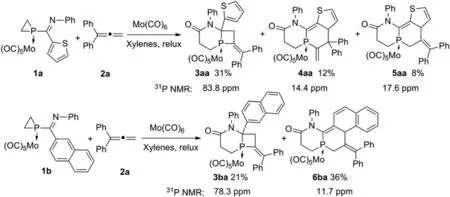
Scheme 2.Reactions of 1-iminylphosphirane complex 1a and 1b with 1,1-diphenylallene 2a.
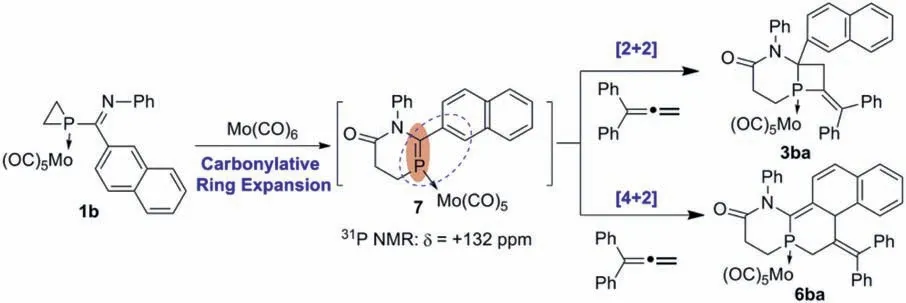
Scheme 3.Plausible reaction pathway.

Table 1 Reaction of phosphirane complexes 1c-1e with allenes 2a-2e.
In summary, we describe a cascade carbonylative ring expansion and[2+2]/[4+2]cycloaddition of 1-iminylphosphirane complexes with aryl allenes.Particularly, [2+2]/[4+2]cycloaddition in the second step could be modulated by the aryl substituents on the imino carbon of phosphirane complexes.High aromatic benzenoid improved the [2+2] cycloaddition selectivity and providing a practical entry to a variety of bicyclo[4.2.0]octan-4-one skeletons featuring phosphacyclobut-ane rings.While dearomatic [4+2] cycloaddition was preferred with naphthalene and yielded octahydrochrysene skeleton containing heteroatoms.
Declaration of competing interest
The authors declare that there are no conflicts of interest.
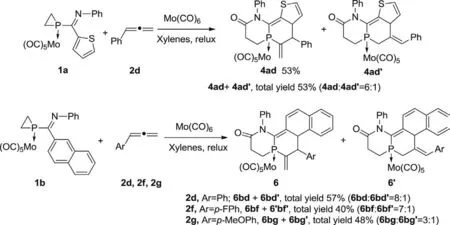
Scheme 4.Reactions of 1-iminylphosphirane complex 1a and 1b with 1-arylallene 2.
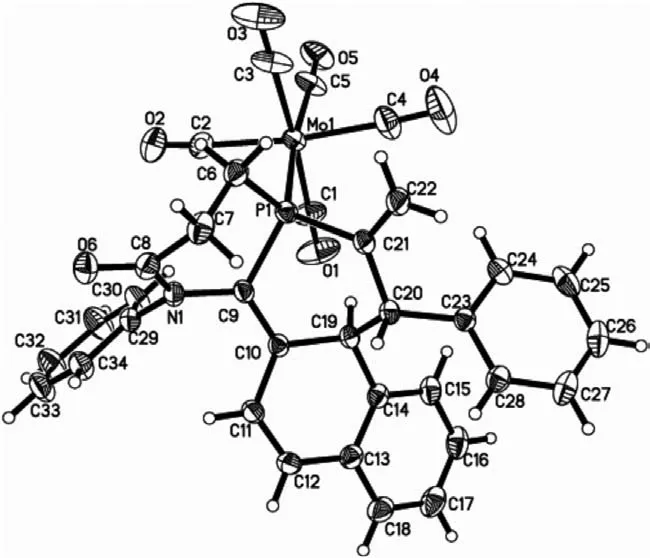
Fig.2.Molecular structure of diphosphane 6bd.Selected distances [Å]and angles[°]: P1-C6 1.839(4), P1-C9 1.820(3)(3), P1-C21 1.841(4), C21-C22 1.314(5), C8-O6 1.212(5),P1-Mo1 2.5104(12).C6-P1-C21103.48(18),C6-P1-C9 98.04(19),C9-P1-C21 97.31(16).
Acknowledgments
This work was supported by the National Natural Science Foundation of China (Nos.21302174, 21672193 and 21272218),China Post-doctoral Science Foundation (No.2017M622362),Ministry of Industry and Information Technology of the People's Republic of China (No. Z135060009002), Key Research Projects of Universities in Henan Province (No.20A150040) and Zhengzhou University of China.
Appendix A.Supplementary data
Supplementarymaterialrelatedtothisarticlecanbefound,inthe online version,at doi:https://doi.org/10.1016/j.cclet.2020.05.026.
杂志排行
Chinese Chemical Letters的其它文章
- A biomass based photonic crystal made of “konjac tofu”
- Hydrothermal-assisted grinding route for WS2 quantum dots (QDs)from nanosheets with preferable tribological performance
- Superiority of poly(L-lactic acid) microspheres as dermal fillers
- Zwitterionic comb-like lipid polymers encapsulating linalool for increasing the fragrance retention time
- Construction of a nano-rectangular Zn-Nd complex with near-infrared luminescent response towards metal ions
- Synthesis and structure of Au19Ag4(S-Adm)15 nanocluster:Polymorphs and optical properties
